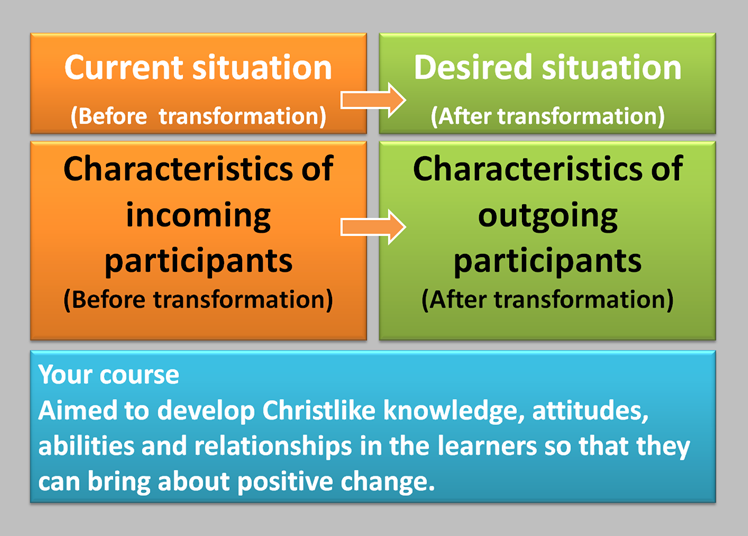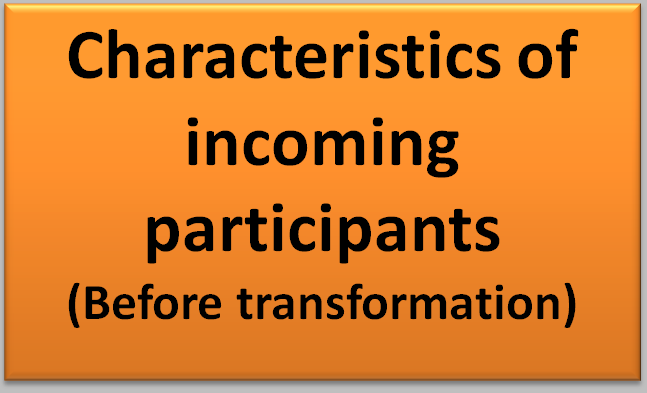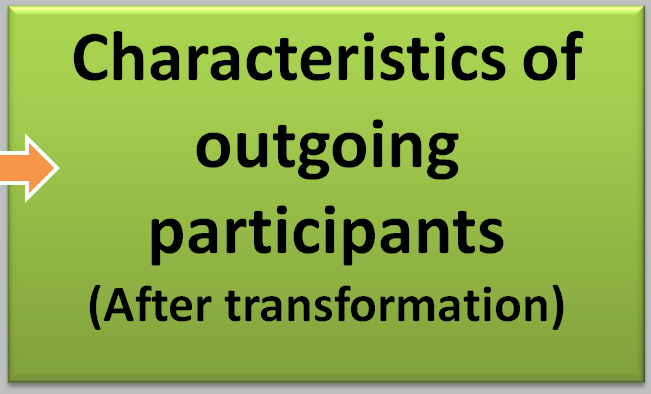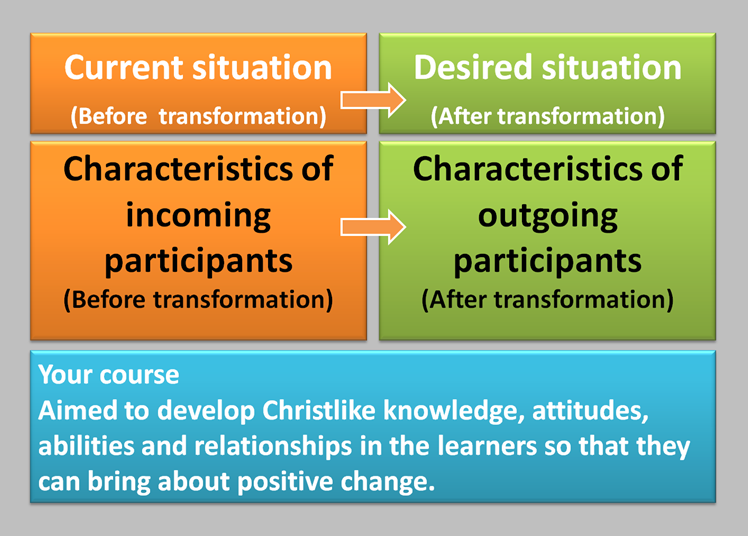Okay, so far we have discussed ARA and making learning transformational and objectives. But what is the framework that we are using that brings all of this to life in real training scenarios?
Our team has been debating/discussing whether we should use Action Reflection Action (ARA) or Situational Response Development (SRD) to describe the methodology we are developing and using to work with ministries with several organizations in many countries. My own preference so far has been to use SRD because the start and end is the situation. ARA is the educational methodology that we encourage as the way to accomplish the transformed situation. (Yesterday I suggested SARA – Situational Action Reflection Action!) 🙂
Okay, so here is the framework that we use for helping teams create their own responses to the situations that they want to address/change.

First and foremost, you start with a local situation that the local team wants to address, or in which they want to see positive change. Then you move to the local learners and evaluate what they need to become the agents of change. They are the ones who will bring about the desired change so the course, or learning inputs, need to develop competence in the learners. ARA will come into play here.
This is not done in isolation or by a sequestered team. The process necessitates active research and analysis of the situation and of the learners. This is all done by the local creators of the training, not by an outside expert in the topic. We have seen over and over in dozens of countries that there is great dynamism in this approach. Using this SRD framework means that the experts are those who are local. The outsiders do not know the situation nor do they pretend that they do know it. This is the same with the learners: the local leadership know their learners and the outsider does not.
We outsiders do bring expertise but that expertise is just to lead them through the process.
Here is the process we do when we lead workshops for organizations that want to move to a more transformational model of training.
In teams, discuss situations that you would like to see change.

Be sure to discuss situations, not topics. Also, try to be realistic. We give plenty of time for teams to discuss and interact on this, perhaps two hours. We then have the teams report the situations to the other teams.
Next, discuss what the transformed situation looks like.
 This is where the teams dream. They spend another couple of hours discussing what the desired situations would look like. This is another place where they can become unrealistic — The economic situation in our country will stabilize, for example. Dreaming is okay here but it is probably good to direct them towards thinking of more realistic changes to the situations they might want to change.
This is where the teams dream. They spend another couple of hours discussing what the desired situations would look like. This is another place where they can become unrealistic — The economic situation in our country will stabilize, for example. Dreaming is okay here but it is probably good to direct them towards thinking of more realistic changes to the situations they might want to change.
I should add here that really we are presenting the process and that if they miss the mark on choosing a situation, one that is too unrealistic to change, for example, that is okay. As long as they know the process then they can work out a more realistic response later.
After reporting on the desired situation as defined by them, they focus on the learners in a similar way.
First, who are your learners and what are they like?
 It is here that we can get more realistic with what can actually be accomplished in the situation. Again, we ask the teams to spend a significant amount of time listing and describing the learners as they currently are. This includes things like gender, position in society, education level, economic situation, roles. You get the idea.
It is here that we can get more realistic with what can actually be accomplished in the situation. Again, we ask the teams to spend a significant amount of time listing and describing the learners as they currently are. This includes things like gender, position in society, education level, economic situation, roles. You get the idea.
After the teams report on their learners as they are now, the teams discuss and list the characteristics of the learners after they have been through the training developed by the team.
 Note that they do not discuss how to get them to be those transformed learners. This is again dreaming about how the transformed learners would be competent to bring about the desired situation. Here an emphasis is put on becoming competent. What do the learners need to be successful agents of change in the situation? One ministry states that
Note that they do not discuss how to get them to be those transformed learners. This is again dreaming about how the transformed learners would be competent to bring about the desired situation. Here an emphasis is put on becoming competent. What do the learners need to be successful agents of change in the situation? One ministry states that
if there is no evidence of change in the situation then you haven’t finished the course!
I love that.
Again, we have each team report on their dream learners.
The workshops are just to introduce this process. The process calls for fairly intense research/analysis/investigation into the current situation after the workshop. The process also calls for fairly intense analysis of the actual students who are the target audience for the training. This input from the situation and the learners is essential for there to be a locally relevant response to the situation.
It is only after the analysis of the situation and of the learners that work can begin on developing the response.
 Here we use the name “course” but we prefer to use “learning inputs” so that we don’t think of the normal classroom lecture situation. This is important because this framework and ARA are not compatible with the standard way that education is done around the world. *See Richard’s comment on this below.
Here we use the name “course” but we prefer to use “learning inputs” so that we don’t think of the normal classroom lecture situation. This is important because this framework and ARA are not compatible with the standard way that education is done around the world. *See Richard’s comment on this below.
You will note that competence includes knowledge, attitudes, abilities and relationships. This is based on the know, be, do objective types that are typically used in education. We have other words, but the emphasis here is that we are building competence in the learners not knowledge for the students.
Because the teams must return to their local situations and spend considerable time researching their situations and their learners, we do not include in the first workshop how to develop the learning inputs. Thoroughly understanding the situation and the students will help tremendously in knowing how to develop the course/training/learning inputs. A follow-up workshop should be scheduled to guide developing the response (training) that would include guidance on how to use ARA.
 It is surprising how such a simple approach to creating and delivering training brings about transformation. It is also surprising how many good educational principles and practices are brought together in this process. This is especially helpful because we are working with people without an education background.
It is surprising how such a simple approach to creating and delivering training brings about transformation. It is also surprising how many good educational principles and practices are brought together in this process. This is especially helpful because we are working with people without an education background.
If you have interest in knowing more about this or in having our team interact with you on how this might be implemented within your organization, you can reply to this post. (Website will be running soonish.)


Comments
Richard Morris
8th September 2017 6:38am
Great explanation of our process. I use the term "learning responses" instead of courses. Learning responses can be courses, workshops, seminars, coaching, written guides or a mix of several.
Send a Reply
Replies
Nicholas
8th September 2017 8:46am
Thanks, Richard. As you stated in a recent report on your work with the team in Nairobi:
"It is interesting that the word “response" has caught on as the thing that is developed by the trauma team using the ARA process."
Send a Reply
Replies
Regina Manley
8th September 2017 12:52pm
I like Nicholas description that used several words to describe what was being developed "course/training/learning inputs." The same phrase could be good in the call out box to amplify "your course" to include the variety of needs our partners present.
The term "learning inputs" helps us to move away from a focus on data transfer of information, but I think it is important to emphasize social dynamic of interacting with one's cohort and with one's local community as an inherent part of the process of developing the envisioned learning response. That has always been the heart of ARA, but the words are easily misconstrued to be far less, especially by those from cultures with strong individualistic tendencies.
Send a Reply
Replies
Send a Reply